GSWM Home Page: NCAR/HAO
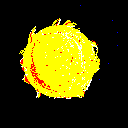
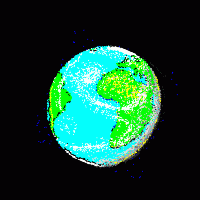 GSWM: Global Scale Wave Model
GSWM: Global Scale Wave Model
A Numerical Model of Planetary Waves and Solar Tides in the Earth's Atmosphere
High Altitude Observatory (HAO)
National Center for Atmospheric Research (NCAR)
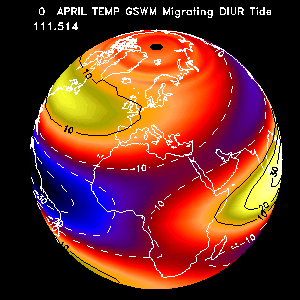
GSWM-98 24-hr Tidal Temperature Perturbation (K) for April, 111km.
Click for animation with alternating "Earth" vs. "Space" frame of reference(1.5M).
(Animation runs 4 loops; [ESC] stops it!)
References / Introduction / Overview / Migrating Diurnal Tidal Results / Migrating Semidiurnal Tidal Results / Combined Harmonics
Contact:
Maura Hagan
(hagan at ucar.edu)
- Overview of Atmospheric Tidal Waves
- NOT the lunar ocean tide
- Driven by thermal forcing
- Harmonics: 12hr; 24hr; etc.
- Outline of Classical solution
Back to Top of GSWM page.
- Features
- 2-dimensonal, linearized, steady-state assumptions
- Solves for non-migrating or migrating waves
- Realistic zonal mean atmosphere (a priori)
- ASCII output format
- Background Climatologies
- Realistic empirical wind, temperature, pressure, density, and ozone zonal mean backgrounds
- Forcing
- Thermospheric absorption of solar extreme ultraviolet (EUV) radiation
- Absorption of solar radiation in the Schumann-Runge (S-R) bands and continuum in the mesopause region
- Strato-mesospheric absorption of solar ultraviolet (UV) radiation
- Tropospheric absorption of solar infrared (IR) radiation
- Tropospheric latent heating associated with deep convective activity (DCA)
- Dissipation
- Ion drag
- Thermal conductivity
- Molecular diffusivity
- Eddy diffusivity
- Gravity wave drag
- Description of Output
- Sample code to read ASCII output file
Back to Top of GSWM page.
- Response to IR- and UV-Driven Thermal Forcing is Out of Phase, Reducing Amplitude of Perturbation
- Interactions with Gravity Waves in Mesosphere Reduces Amplitude in Lower Thermosphere
- Higher Equinox Amplitudes
- Amplitude Peaks occur in Mid- to Low Latitudes
- ~25km vertical wavelength
GSWM-98 8-Panel Amplitude and Phase Contour Plots on a Grid of Altitude vs. Latitude:
Zonal, Meridional, and Vertical Wind, & Temperature Perturbations (8.5" X 11" .gif).
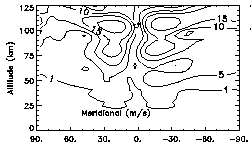
- January (Solstice) in Color(25k)
or in BW(18k)
- April (Equinox) in Color(28k)
or in BW(19k)
- July (Solstice) in Color(26k)
or in BW(18k)
- October (Equinox) in Color(28k)
or in BW(19k)
GSWM-98 Animated Diurnal Plots
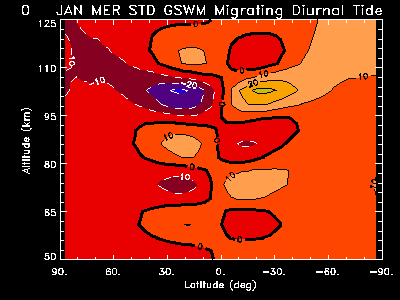
Pseudocode to read the files (FORTRAN)
Procedure to read the files (IDL)
Back to Top of GSWM page.
- Smaller Amplitude Perturbations than Diurnal Tide in Mesosphere
- Longer Wavelength than Diurnal Tide
- Major Amplitude Peaks occur at Mid- to High Latitude, Shift with Season
- Highest Amplitudes occur in Lower Thermosphere
- ~50km vertical wavelength
GSWM-98 8-Panel Amplitude and Phase Contour Plots on a Grid of Altitude vs. Latitude:
Zonal, Meridional, and Vertical Wind, & Temperature Perturbations (8.5" X 11" .gif).
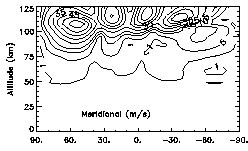
GSWM-98 Animated Semidiurnal Results
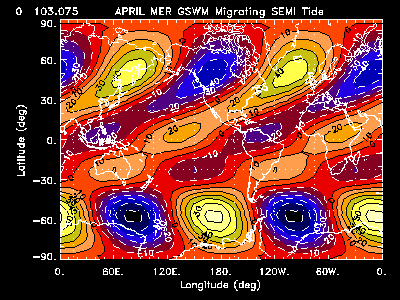
Pseudocode to read the files (FORTRAN)
Procedure to read the files (IDL)
Back to Top of GSWM page.
Graphical Output from Combined GSWM-98 Migrating Harmonics
- Semidiurnal Component Dominates in Lower Thermosphere
- Semidiurnal Component Stronger at Higher Latitudes
- Diurnal Component Dominates in Mesosphere near Equator/Subtropics
- Seasonal Dependence due to Respective Diurnal, Semidiurnal Seasonal Shifts
January Meridional Latitude vs. Longitude at 100km.

NCAR homepage.
 HAO homepage.
HAO homepage.
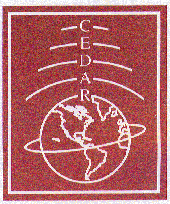 CEDAR homepage.
CEDAR homepage.
Developed by Jeremy Hackney; Approved by Maura Hagan: 17 July 1998
Last Updated by Maura Hagan (hagan at ucar.edu): 17 March 2004
Copyright 1998, NCAR.








 CEDAR homepage.
CEDAR homepage.